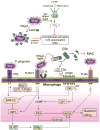Breaking bad: manipulation of the host response by Porphyromonas gingivalis
- PMID: 24338806
- PMCID: PMC3925422
- DOI: 10.1002/eji.201344202
Breaking bad: manipulation of the host response by Porphyromonas gingivalis
Abstract
Recent metagenomic and mechanistic studies are consistent with a new model of periodontal pathogenesis. This model proposes that periodontal disease is initiated by a synergistic and dysbiotic microbial community rather than by a select few bacteria traditionally known as "periopathogens." Low-abundance bacteria with community-wide effects that are critical for the development of dysbiosis are now known as keystone pathogens, the best-documented example of which is Porphyromonas gingivalis. Here, we review established mechanisms by which P. gingivalis interferes with host immunity and enables the emergence of dysbiotic communities. We integrate the role of P. gingivalis with that of other bacteria acting upstream and downstream in pathogenesis. Accessory pathogens act upstream to facilitate P. gingivalis colonization and co-ordinate metabolic activities, whereas commensals-turned pathobionts act downstream and contribute to destructive inflammation. The recent concepts of keystone pathogens, along with polymicrobial synergy and dysbiosis, have profound implications for the development of therapeutic options for periodontal disease.
Keywords: Dysbiosis; Immune subversion; Inflammation; P. gingivalis; Periodontitis.
© 2013 WILEY-VCH Verlag GmbH & Co. KGaA, Weinheim.
Conflict of interest statement
Figures



References
-
- Stecher B, Maier L, Hardt WD. ‘Blooming’ in the gut: how dysbiosis might contribute to pathogen evolution. Nat Rev Microbiol. 2013;11:277–284. - PubMed
Publication types
MeSH terms
Grants and funding
- RC4 DE021580/DE/NIDCR NIH HHS/United States
- R01 DE011111/DE/NIDCR NIH HHS/United States
- R01 DE015254/DE/NIDCR NIH HHS/United States
- DE011111/DE/NIDCR NIH HHS/United States
- DE017921/DE/NIDCR NIH HHS/United States
- R01 DE016690/DE/NIDCR NIH HHS/United States
- R37 DE011111/DE/NIDCR NIH HHS/United States
- DE016690/DE/NIDCR NIH HHS/United States
- DE021580/DE/NIDCR NIH HHS/United States
- DE015254/DE/NIDCR NIH HHS/United States
- DE022867/DE/NIDCR NIH HHS/United States
- R01 DE012505/DE/NIDCR NIH HHS/United States
- R01 DE021685/DE/NIDCR NIH HHS/United States
- R01 DE017138/DE/NIDCR NIH HHS/United States
- DE012505/DE/NIDCR NIH HHS/United States
- R21 DE022867/DE/NIDCR NIH HHS/United States
- R01 DE017921/DE/NIDCR NIH HHS/United States
- DE021685/DE/NIDCR NIH HHS/United States
- DE017138/DE/NIDCR NIH HHS/United States
LinkOut - more resources
Full Text Sources
Other Literature Sources
Medical
Research Materials

